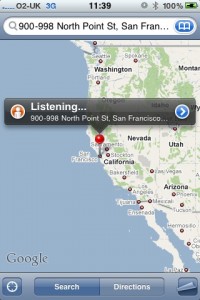Ten Apps that I’d like to see on the iPhone. I’m also suggesting names for these. To be honest, I’d like to pull together a team to build them but that seems to be a lot more difficult than I’d hoped. If anyone wants to call me and work with me to pull together funding, then you know where to get me.
- MeetFreak/TrendSeek
Helps people find each other by abusing Twitter trends and trying to suck Location Data in there. This is a lot easier now that Twitter is supporting GeoTags. So, let us see a map of trends? People are talking about #RED, where are they talking about it? Let us see every tweet with the Trend on a map that we can see. Then you’re more likely to be able to congregate with people - Multitool
Uses the five tabs along the bottom to give you a view of
1) IMAP account
2) Web Browser
3) Twitter
4) Mapper
5) Converter/Calculator
Redirects all http:// and mailto: seen inside the app, to the app and not outside so doesn’t launch Safari or Mail. A lot of this is kinda redundant when we have decent clients for much of this inside Safari. But some offline caching is a big deal for those of us who tend not to be inside the city centres where you can get decent 3G. - Verifriend, Reputato
This is an online reputation profiler. Yes, it’s going to be a popularity contest but essentially it all depends on trust. Adding your rating to someone is not something to be done lightly. In some ways it needs to be a trust engine – and it can be as simple as giving a trust rating to a new friend based on the trust ratings that others have provided. There needs to be some sort of anonymity (maybe like the reviews process on iTunes you only get a rating when a certain number of reviews have been processed) but unlike FaceBook it should provide that extra level of security. - Director
Allows me to text directions to someone who asks me on the street. In plain text. Or Bluetooth them. Or even just email them. Or something. Or magic them straight into their brain. Any of these things would be fine. Just so I don’t have to try to explain the directions to someone. - REDACTED
This one was so good, someone asked me to take it down. 🙂 Suffice to say it was AR related. - Tweet16
Twitter lists are all very well but they don’t solve th problem I have. I follow about 1000 people but there’s probably less than 150 or so (that magic Dunbar number) whom I regularly interact with. There’s probably only 10% of those whom I really want to pay attention to. I’d like a Twitter client that shows me my timeline, my mentions, my DMs and finally, my Tweet16 – 16 people from whom I see all of their public messages rather than not seeing the ones who are at people I don’t follow. - Plannity
So, I fill in all of this information into my calendar and that includes times and dates and, most crucially, locations of my meetings. Why hasn’t there been a social app that runs via Exchange/Outlook, on iPhone, iCal and other formats which takes this location information, munges it up with my social network and allows me to see when I can grab lunch with friends or when I’m in the same town as someone I like. I think that Tripit is meant to do this and today I read about Plancast which promises to do something about this. But this is a hot topic, guys. Location is the big thing for 2009/2010. - Echelon (or TwitterBug)
I mentioned this a week ago – a cool idea for Twitter and other social networks which again uses location. So – get this – all of your messages are geotagged, or if not now, a lot of them will be. So, Echelon ‘listens’ in for anything said in an area rather than things said about trends or by your friends. The default set is seeing tweets which are in your immediate area – the killer part though is being able to drop a ‘bug’ (for bug, read ‘pin’) on a map and be able to sample the Tweets going through that area and the surrounding radius. So, in effect, you’ve dropped a Twitter Bug somewhere and you’re able to listen in. The Freemium version could monitor one location, the PayFor version could monitor several. ( ECHELON is a name used in global media and in popular culture to describe a signals intelligence (SIGINT) collection and analysis network operated on behalf of the five signatory states to the UK-USA Security Agreement (Australia, Canada, New Zealand, the United Kingdom, and the United States) - The Official CIA Manual of Trickery and Deception
Perfect for the Sandbagger or Spook among us, this is a recently published book derived from an official manual. As most of them are small pictorial sessions, they’re ripe for viewing on the iPhone, turning the iPhone into the ultimate tradecraft manual. You can see clips from the book on Gizmodo. So scan it, make it searchable so you can quickly flick through and find the perfect tradecraft for the perfect moment. - Pollenator
For public debates, a simple push notification which opens the app and gives you a simple couple of choices accompanied with text, audio or video. Push one, it’s recorded (with time, place, ID, IMEI and whatever other data you have collected and after a certain amount of time, the poll times out. Poll answers should be “Yes”, “No” or “Whatever”. If you choose to ignore or “Whatever” it, then you’re counted as an abstention. I’d love to see this app running and see visualisations of what it could bring in terms of demographics, location and other meta data. I sat with Stuart and Phil (and with PJ on the end of a Skype call) one evening and we mocked up some stuff for this based on Stuarts idea of “Pirates versus Ninjas”. But the actual implementation could have led to entirely other applications.



I’d love to see all of these on my iPhone. Id love to talk more about these apps to people who are interested. I’d love even more to be involved in the group/company/whatever that was going to make some of these.
Please comment if they inspired you or if you’re working on something similar.
